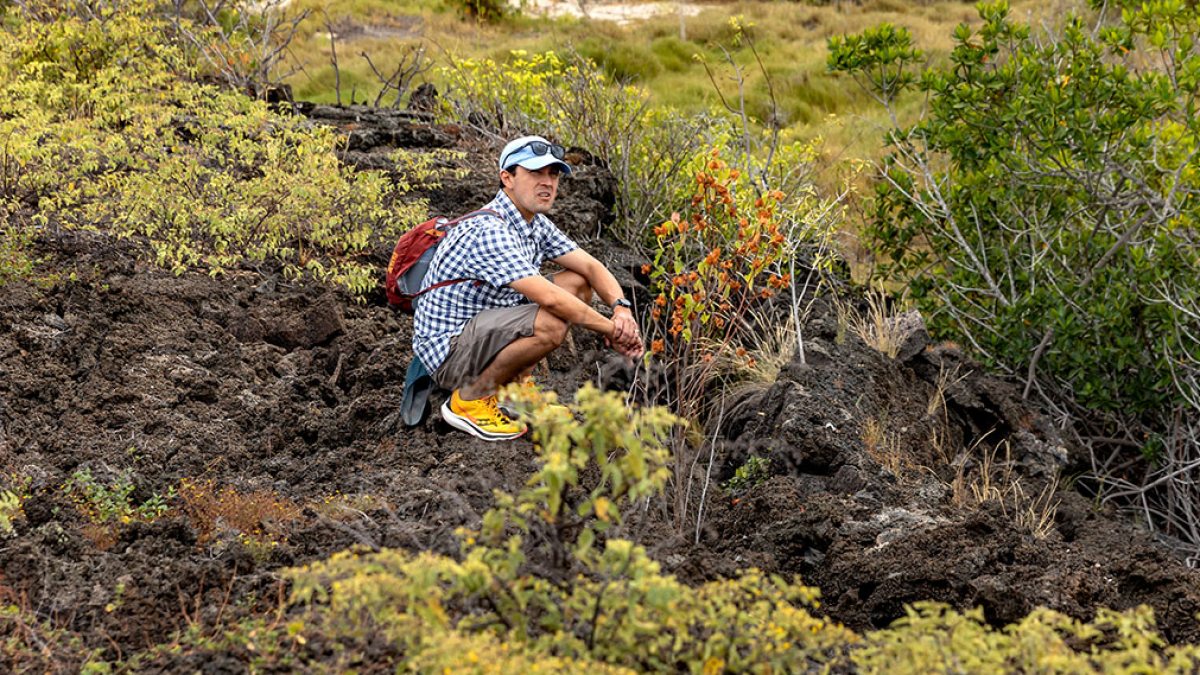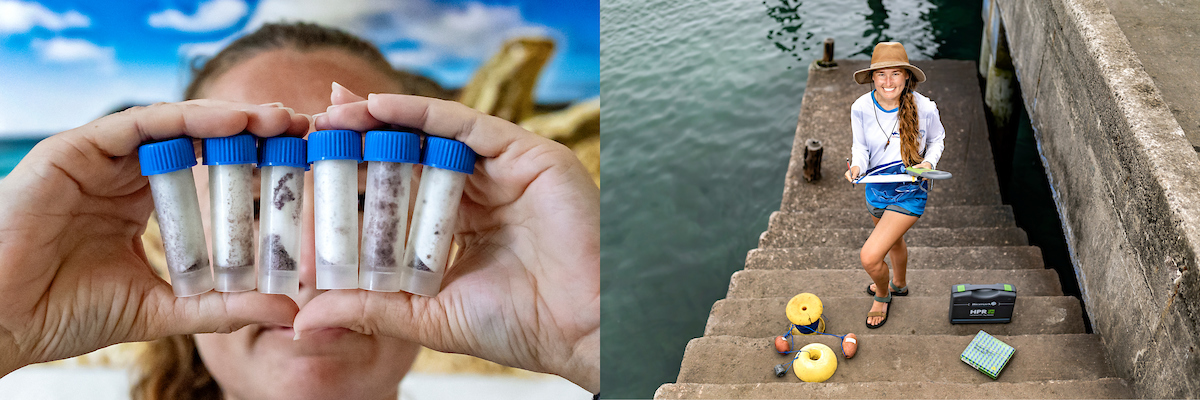In the field with Galapagos researchers
Meet Carolina researchers who are conducting their work more than 2,600 miles away from Chapel Hill in the Galapagos Islands.

Carolina researchers conduct groundbreaking research around the world.
One of our most significant research footprints abroad is the Galapagos Science Center on San Cristobal Island. The 20,000-square-foot facility is a partnership between UNC-Chapel Hill’s Center for Galapagos Studies and the Universidad San Francisco de Quito and is the only center of its kind on the islands.
The center is home to research on terrestrial ecology, marine ecology and oceanography, microbiology and genetics and geospatial technologies, which can all be applied to similar islands around the world. Since opening in 2011, the Galapagos Science Center has been the site of more than 100 interdisciplinary research projects led by hundreds of national and international scientists.
Meet some of the Carolina researchers who are conducting their research more than 2,600 miles away on the Galapagos Islands

Bruno holds a Galapagos brittle star — an “echinoderm” that is related to sea urchins and sea stars.
John Bruno, a marine ecologist and professor in the biology department in the College of Arts and Sciences
The research in Bruno’s lab is focused on the biodiversity of the ocean, particularly the impacts climate change has on marine species and ecosystems. Bruno and his team study how human activities like fishing and energy production from fossil fuels alter the structure and functioning of marine food webs and what local conservation strategies are effective in mitigating these impacts.
His team is also working to take photos of the marine species around the Galapagos to “share the incredible beauty of these crazy critters with the public, particularly tourists who visit the Galapagos. We will also use these images as part of an effort to describe and catalog all the marine life in this region.”
“After 25 years of documenting the rapid decline of coral reef ecosystems, I was beyond burnt out. Starting to work in the Galapagos — a relatively intact marine ecosystem — was critical to restoring my mental health and hope for our future. It’s far from pristine, but the Galapagos is one of the few places on Earth you can still easily see large vertebrate predators. It’s like a time machine that can take you back centuries to see what the ocean looked like before over-harvesting and climate change devastated most the world’s marine habitats.
“Once I got here, I realized there’s remarkably little known about most of the species that inhabit this unique system. There’s so much work to be done here, but that means endless opportunities for really impactful student research. It’s a perfect classroom for the undergraduate and graduate students that work with me to learn about natural systems, field methods, and the challenges of doing field science.”

Silva holds wet macroalgae from the Ulva genus that is ready to be dried. With this process, she can calculate algal biomass in the sample.
Isabel Silva,marine ecology Ph.D. student in the biology department in the College of Arts and Sciences
Silva is studying how macroalgal availability in the Galapagos’ rocky reefs is impacted by temperature, grazing herbivores and upwelling. Her work examines how algal biomasses — the base of the marine food web— respond to environmental changes, addressing a knowledge gap about ecological processes such as top-down and bottom-up controls of this unique ecosystem.
“The Galapagos Islands are important for this research because its marine ecosystems are complex, unique, enormously dynamic and certainly influenced by the Anthropocene. Using this place as a study model can help us understand how species interactions and ocean productivity will be directly and indirectly affected in the near future.”
Diego Riveros-Iregui, interim co-director of the UNC Center for Galapagos Studies and Bowman and Gordon Gray Professor in the geography department in the College of Arts & Sciences
Riveros-Iregui researches the interactions and feedbacks between water and ecosystems, including soils, plants, microbes and the atmosphere, with a focus on elements such as carbon and nitrogen.
“Currently, we need to enhance our understanding of how soils and ecosystems will respond to changes in water availability — changing rainfall patterns, prolonged drought, etc. The work that my students and I do seeks to fill these knowledge gaps and provide new information that can help us assess the sustainability of our natural resources.
“The Galapagos Islands offer a variety of environments as a result of sharp gradients in age, hydroclimate and human impacts. This includes very dry and very humid areas with drastically different vegetative covers that may occur very closely to one another. My group and I study this natural laboratory to evaluate current threats to freshwater security and resource sustainability, as well as the coupling of human activities with ecosystem dynamics and function.”

Ryburn holds tubes that contain water filter papers that are used for extracting DNA samples from the water to study the habitat of juvenile scalloped hammerhead sharks.
Savannah Ryburn, Ph.D. student in the the College of Arts & Science’s Environment, Ecology and Energy Program
Ryburn is creating a comprehensive assessment of the ecology and habitat of juvenile scalloped hammerhead sharks in the Galapagos. Little is known about this species of shark at the juvenile stage, including how long they reside in the nursery habitats, movement among nurseries, diet and why certain bays are chosen as nurseries.
The Tar Heel’s research uses satellite and identification tags to investigate the sharks’ movement, DNA analysis of shark fecal matter to describe their diet and measurements of environmental characteristics, such as water temperature and salinity, to characterize the nursery bays. From her data, she can determine what animals have been in the bay — essentially their menu of what is available to eat — and what the sharks are choosing to eat off of that menu.
“Shark nursery grounds often consist of coastal, protected bays and estuaries, which can be susceptible to increased pollution, tourism and fishing. Scalloped hammerhead sharks are critically endangered globally and have experienced dramatic declines in the eastern Pacific population. Therefore, it is essential to identify nursery grounds in the Galapagos that could potentially increase the resilience of adult populations and incorporate them into management plans throughout all life stages, not just as adults.
“The Galapagos are very important for my research because recently, a few scalloped hammerhead nursery grounds have been discovered throughout the archipelago. This species is iconic to the islands because they are known to school there in large numbers as adults. If we can increase their chance of survival as juveniles, we can hopefully aid in the recovery of their overall population.”
Will Vizuete, professor in the UNC Gillings School of Public Health’s environmental sciences and engineering department
A leading cause of global premature deaths is exposure to ozone and aerosols. Aerosols alone are responsible for up to 8 million premature deaths worldwide and are an important atmospheric radiative forcer, playing a critical role in our understanding of the impacts of climate change. Tackling problems of air pollution mortality and climate change are the global public health issues that motivate Vizuete’s research.
“An important contributor to aerosols in the atmosphere are the oceans, and the Galapagos is an ideal location to study how the pristine ocean can produce them. The instrument I am holding collects these aerosols on a filter, allowing us to bring them back to UNC and determine their composition and learn where they came from. We are also trying to look for any microplastics on the filter to learn whether the atmosphere is also a contributor of plastics to the oceans.
“Although we know that aerosols from the oceans are an important global source, we know very little about how they are formed or what they are comprised of. This lack of knowledge hinders our ability to understand how these aerosols impact a future climate. The Galapagos provides both a pristine natural location and a state-of-the-art science facility found at the Galapagos Science Center. The center fosters interdisciplinary teams where I can work with experts from both the oceanic and atmospheric sciences and generate new discoveries on how the oceans form aerosols.”






